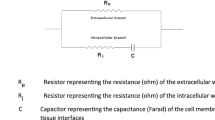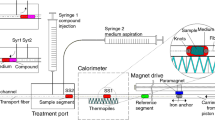Abstract
The application of the guard ring has been advanced as a method for focusing the applied current in performing electrical-impedance measurements of volume conductors. The objective is to obtain impedance and/or its variation at localised regions of heterogeneous tissue. The paper discusses the capabilities and limitations of both guarded and unguarded measurements and shows that the application of guarding does not, normally, fulfil the capabilities being ascribed to it. A comparison is made of the guarded system under constant-current and constant-voltage constraints with an unguarded electrode system, and it is shown that the guarded system does not have any significant advantages.
Sommaire
Certains auteurs ont recommandé la méthode de l'anneau de garde pour focaliser le courant appliqué lors de la mesure de l'impédance de volumes conducteurs. L'objectif est de déterminer la valeur et/ou les variations de l'impédance en des régions données d'un tissue hétérogène. Cet article discute des possibilités et limites de mesures avec électrodes gardées et non gardées et montre que les premières n'ont pas les performances qu'on leur accorde généralement. Une comparaison entre le système à électrode protégée sous intensité et voltage constant par rapport à un système à électrode non protégée montre que le système protégé ne présente aucun avantage significatif.
Zusammenfassung
Die Verwendung des Abwehrrings wurde als Methode für das Fokussieren des angelegten Stroms bei der Durchführung von Messungen der elektrischen Impedanz von Volumenleitern vorgeschlagen. Das Ziel ist, Impedanz und/oder ihre Variation in lokalisierten Regionen heterogenen Gewebes zu erhalten. Dieser Aufsatz bespricht die Möglichkeiten und Beschränkungen sowohl abgeschirmter als auch nicht abgeschirmter Messungen und zeigt, daß die Verwendung von Abschirmung normalerweise die ihr zugeschriebenen Möglichkeiten nicht erfüllt. Ein Vergleich wird angestellt zwischen dem abgeschirmten System unter konstanter Strom- und konstanter Spannungseinschränkung und dem nicht abgeschirmten Elektrodensystem, und es wird gezeigt, daß das abgeschirmte System keinerlei wesentliche Vorteile bietet.
Similar content being viewed by others
References
Allison, R. D. (ed.) (1970)Basic factors in bioelectric impedance measurements. Instrument Society of America, Pittsburgh, Pa.
Cooley, W. L. andLongini, R. L. (1968) A new design for an impedance pneumograph.J. Appl. Physiol. 25, 429–432.
Geselowitz, D. (1971) An application of electrocardiographic lead theory to impedance plethysmography.IEEE Trans. BME-18, 38–41.
Giolma, J. P. andCooley, W. L. (1973) Observations of variations of lung and cardiac related thoracic impedance waveforms.Proceedings of the 26th annual conference on engineering in medicine and biology, 64.
Graham, M. (1965) Guard ring use in physiological measurements.IEEE Trans. BME-12, 197–198.
Grenvik, A. et al. (1972) Impedance pneumography.Chest 62, 439–443.
Jarzembski, W. B. (1973) Forced impedance and guarding for physiological impedance measurements.Proceedings of the 26th annual conference on engineering in medicine and biology, 65.
Lehr, J. (1972) A vector derivation useful in impedance plethysmographic field calculations.,BME-19, 156–157.
Lehr, J. Theoretical plethysmography. Personal communication.
Lehr, J. L., Cooley, W. L. andLongini, R. L. (1975) Measurement of regional differences in thoracic electrical impedance using guard electrodes.Proceedings of the 28th annual conference on engineering in medicine and biology 17, 57.
Lifshitz, K. (1970) Electrode impedance cephalography. Electrode guarding and analog studies.Ann. NY Acad. Sci. 170, 532–549.
Markovich, S. E. (ed.) (1970) International conference on bioelectric impedance.Ann. NY Acad. Sci. 170, 407–836.
McFee, R. andJohnston, F. D. (1953, 1954a, 1954b) Electrocardiographic leads.Circulation 8, 554–568;9, 255–266;9, 868–880.
Michels, W. C. (1957)Electrical measurements and their applications. D. Van Nostrand, New York.
Monteath, G. D. (1951) Application of the compensation theorem to certain radiation and propagation problems.Proc. IEE 98 Pt. IV, 23–30.
Nyober, I. (1959)Electrical impedance plethysmography. Charles C. Thomas, Springfield, Ill.
Plonsey, R. (1974) The formulation of bioelectric sourcefield relationships in terms of surface discontinuities.J. Franklin Inst. 297, 317–324.
Severinghaus, J. W., Catron, C. andNoble, W. (1972) A focusing electrode bridge for unilateral lung resistance.J. Appl. Physiol. 32, 526–530.
Author information
Authors and Affiliations
Rights and permissions
About this article
Cite this article
Plonsey, R., Collin, R. Electrode guarding in electrical impedance measurements of physiological systems—a critique. Med. Biol. Eng. Comput. 15, 519–527 (1977). https://doi.org/10.1007/BF02442279
Received:
Accepted:
Issue Date:
DOI: https://doi.org/10.1007/BF02442279




